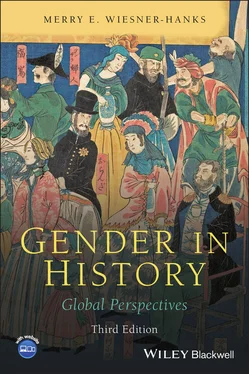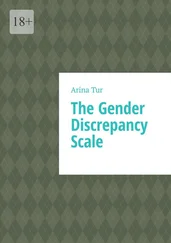Some analysts see a fourth wave of activism starting in the 2010s, again with a wide variety of concerns: sexual harassment, gender violence, reproductive rights, workplace discrimination, rape culture. The #MeToo movement against sexual abuse and sexual harassment, begun by activist Tarana Burke, has sought to empower women to come forward by demonstrating just how widespread the problem was; it spread internationally, prompting survivors to share their stories and in some cases leading to high-profile firings of abusive men or those who enabled a hostile work environment. In Latin America, highly visible movements emerged from Mexico to Argentina raising awareness about gender violence; spreading access to social media mobilized regionwide support for the anti- feminicidio campaign and protests such as the #NiUnaMenos women’s strikes and demonstrations (Figure 2.2). Much of this activism was intersectional, such as the March for Black Trans Lives in Brooklyn in June 2020, which drew 15,000 people, all wearing white, to protest violence and harassment of transgender people. Around the world, feminists now use digital and social media to organize, share ideas, and accomplish their aims (sometimes derisively termed “hashtag feminism”), but also protest the widespread misogyny of online culture.

Figure 2.2 #NiUnaMenos March in Lima, Peru, 2016.
This march in Lima, reportedly the largest protest in Peruvian history, was one of many demonstrations organized as part of #NiUnaMenos (not one less), a Latin American feminist campaign against gender-based violence. Wikimedia Commons. Source, Lorena Flores Agüero .
However they have chosen to label their ideas, and whatever wave they happen to be in, over the past century and a half many people have worked to transform ideals of greater gender equity into laws. These have allowed women to keep their wages and own property, vote and hold office, obtain divorce on an equal basis with men, and receive equal pay for equal work. Laws have allowed gay and trans people to marry and adopt children, join the military, and not lose their jobs because of their sexual orientation or gender identity. Such laws sometimes resulted from changes in widely held attitudes, but sometimes they anticipated widespread social change and were the result of changes in ideas among elites or conquerors. Laws were passed against veiling in Turkey in the 1920s and Iran and Uzbekistan in the 1930s, for example, because the leadership of these countries came to view unveiled women as a symbol of modernity, not because of popular pressure. The Soviets forced through laws against veiling and polygamy when they took over Islamic areas in Central Asia.
When the impetus for legal change came from outside an area or from an elite group, laws were often difficult to enforce. The 1931 Civil Code in China, for example, outlawed arranged marriages and concubinage, but it was not followed in rural areas for decades. Though such lack of compliance comes in some instances from entrenched norms of gender hierarchy, in other places laws were (and are) ignored because women did not view them as beneficial. The 1956 Hindu Succession Act in India, for example, theoretically gave women equal rights to the inheritance of any property their parents themselves had acquired. Its provisions have been scarcely followed, and women have not taken cases to court to assert their rights to property. This is not because they do not know about the law, are too passive, or are too guided by older notions of propriety, but because they seek to optimize their own economic and emotional needs and promote family stability and affections. When they do seek their rights in the courts, the decisions follow the law, but are often expressed in terms of older customary provisions regarding the protection of women and not the newer language of rights.
Sometimes the introduction of new norms can have contradictory results. In post-Soviet Russia, increased interaction with the West has led to greater awareness of egalitarian ideals and practices, but also greater sexism, especially in terms of pornography and the exploitation of the female body in advertising and popular culture that had been forbidden in restrictive and puritanical Soviet culture.
In many parts of the world, the emphasis on the individual in Anglo-American feminism is seen as misguided or even destructive; advocates for women, such as the scholar Ifi Amadiume in Nigeria, point to high levels of poverty and isolation among Western women, especially after divorce. Activists for women’s causes in these areas express their goals in terms of the needs of women and men rather than their rights, and stress the benefits gained by the family and community when women are given greater opportunities.
Because of these differences in emphasis, international measures promoting greater gender equality are always worded very carefully. The 1979 United Nations Convention on the Elimination of All Forms of Discrimination against Women (CEDAW) did describe discrimination against women as a violation of “the principles of equality of rights and respect for human dignity,” but it was also careful to stress the effects of such discrimination on families, society, women’s countries, and all humanity, and not simply on the women as individuals. As of 2021, CEDAW has been ratified by 189 countries, though not Iran, Somalia, Sudan, Tonga, and the United States; some of those that have ratified it have exempted customary, family, and religious law, however, which lessens its impact considerably.
In the first part of the new millennium, ideas, norms, and laws regarding gender appear by some measures to be very resistant to change: a majority of people in India approve parent-controlled marriages; a majority of people in South America have negative views of women taking jobs outside the home; a majority of people (and judges) in North America and Europe regard mothers as “naturally” better parents than fathers, and the list could go on and on. Laws that proclaim gender equality are supported in the abstract, but are often not enforced, and may even be counteracted by other laws – especially those regarding marriage, divorce, and inheritance – which have a much greater impact in terms of day-to-day opportunities than abstract statements. On some issues it is clearly easier to make laws than to change longstanding attitudes and ideas about the proper roles and nature of women and men. Change also produces stress. Some studies of psychological and physical health indicate, for example, that people with more conservative notions of gender are healthier than those who are more open to change,for the uncertainty of change can lead to stress. Thus in times of rapid change, people may hang on to what they see as more “traditional” notions of gender and sexuality as an anchor of stability, and support leaders who promise a return to these.
If one takes a long view, however, even in areas where traditions are very strong, there are clear signs of change in norms and laws. Though laws prohibiting gender discrimination are not always enforced, they are at least part of most constitutions and legal codes developed in the twentieth century, which would have been unthinkable (or regarded as laughable) several centuries earlier. Though some young women hesitate to call themselves feminists, many of the demands of the feminist movement are now accepted as self-evident, at least in theory: equal pay for equal work, access to education, legal equality. And voices proclaiming “we should all be feminists” come from many parts of the world. Grassroots women’s groups are using local and village courts to curtail domestic violence, and exploring religious and cultural traditions for teachings that support greater opportunities for women. They have made it clear that many sources of ideas and norms are ambiguous, and that what really matters is how prescriptive statements play out in the real world.
Читать дальше













